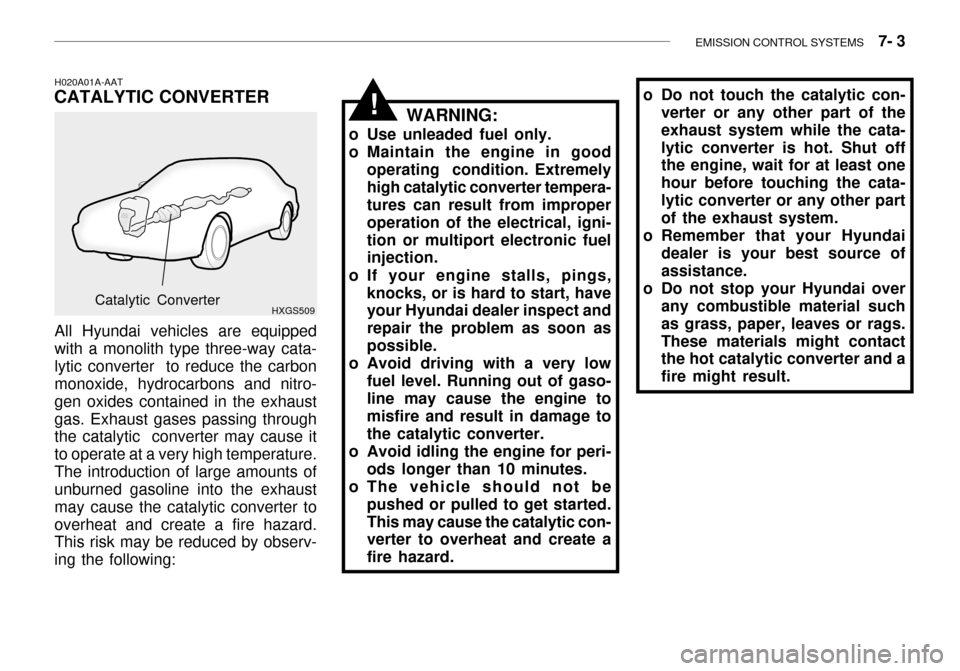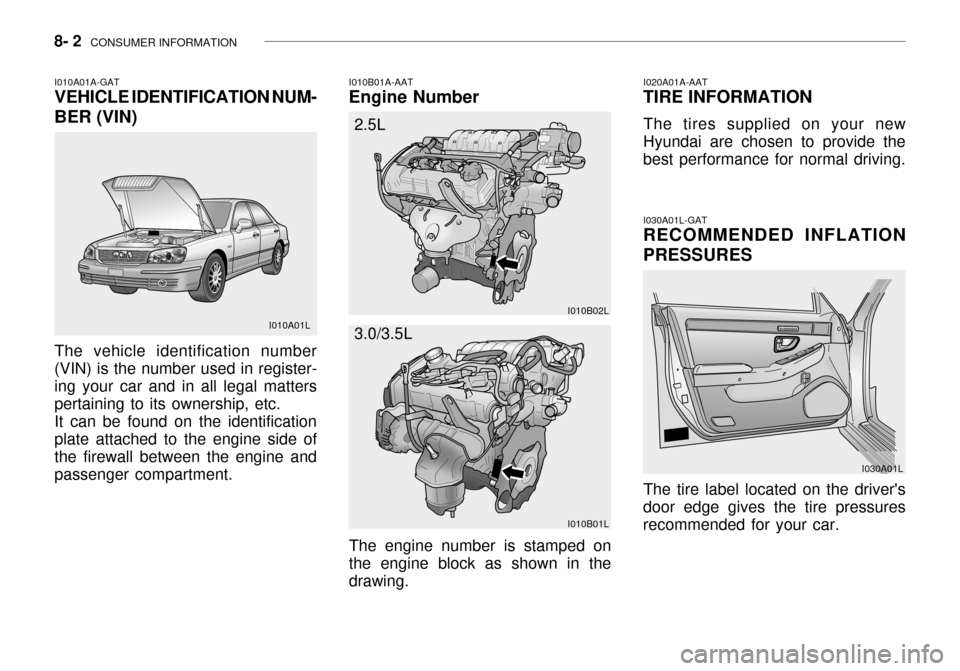2003 Hyundai Grandeur engine
[x] Cancel search: enginePage 218 of 235

7- 2 EMISSION CONTROL SYSTEMS
H010A01A-GAT
EMISSION CONTROL SYSTEM (If Installed)
Your Hyundai is equipped with an
emission control system to meet all requirements of the Emission prohibi-tion rules of your province.
There are three emission control sys-
tems which are as follows.
1) Crankcase emission control sys-
tem
2) Evaporative emission control sys- tem
3) Exhaust emission control system
In order to assure the proper function
of the emission control systems, it is recommended that you have your car inspected and maintained by an au-thorized Hyundai dealer in accordance with the maintenance schedule in this manual. H010B01A-AAT
1. Crankcase Emission Control
System
The positive crankcase ventilation
system is employed to prevent airpollution caused by blow-by gasesbeing emitted from the crankcase. This system supplies fresh air to the crankcase through the air intake hose.Inside the crankcase, the fresh air mixes with blow-by gases, which then pass through the PCV valve and intothe induction system.
H010C02Y-GAT
2. Evaporative Emission
Control System
The Evaporative Emission Control
System is designed to prevent fuel vapors from escaping into the atmo- sphere. Canister
While the engine is inoperative, fuel
vapors generated inside the fuel tank are absorbed and stored in the canis- ter. When the engine is running, the fuel vapors absorbed in the canisterare drawn into the induction system through the purge control solenoidvalve. Purge Control Solenoid Valve
The purge control solenoid valve is
controlled by the ECM; when the en- gine coolant temperature is low, and during idling, it closes, so that evapo- rated fuel is not taken into the surgetank. After engine warm-up, during ordinary driving, it opens so as to introduce evaporated fuel to the surgetank.
H010D01A-AAT
3. Exhaust Emission Control
System
The exhaust emission control system
is a highly effective system whichcontrols exhaust emission while main- taining good vehicle performance.
H010E01Y-GAT
EGR System
This system helps control nitrogen
oxides by recirculating a part of the exhaust gas into the engine, therebyreducing cylinder combustion tem- perature.
Page 219 of 235

EMISSION CONTROL SYSTEMS 7- 3
WARNING:
o Use unleaded fuel only.
o Maintain the engine in good operating condition. Extremelyhigh catalytic converter tempera- tures can result from improper operation of the electrical, igni-tion or multiport electronic fuel injection.
o If your engine stalls, pings, knocks, or is hard to start, haveyour Hyundai dealer inspect and repair the problem as soon as possible.
o Avoid driving with a very low fuel level. Running out of gaso-line may cause the engine to misfire and result in damage tothe catalytic converter.
o Avoid idling the engine for peri- ods longer than 10 minutes.
o The vehicle should not be pushed or pulled to get started.This may cause the catalytic con- verter to overheat and create a fire hazard.
H020A01A-AAT
CATALYTIC CONVERTER
HXGS509
All Hyundai vehicles are equippedwith a monolith type three-way cata-lytic converter to reduce the carbon monoxide, hydrocarbons and nitro- gen oxides contained in the exhaustgas. Exhaust gases passing through the catalytic converter may cause it to operate at a very high temperature.The introduction of large amounts of unburned gasoline into the exhaust may cause the catalytic converter tooverheat and create a fire hazard. This risk may be reduced by observ- ing the following:
Catalytic Converter o Do not touch the catalytic con-
verter or any other part of the exhaust system while the cata-lytic converter is hot. Shut off the engine, wait for at least one hour before touching the cata-lytic converter or any other part of the exhaust system.
o Remember that your Hyundai dealer is your best source of assistance.
o Do not stop your Hyundai over any combustible material suchas grass, paper, leaves or rags.These materials might contact the hot catalytic converter and a fire might result.
!
Page 220 of 235

8. CONSUMER INFORMATIONVehicle Identification Number (VIN) .............................................. 8-2
Engine Number .............................................................................. 8-2
Recommended Inflation Pressures ................................................ 8-2
Snow Tires ...................................................................................... 8-3
Tire Chains ..................................................................................... 8-4
Tire Rotation ................................................................................... 8-4
Tire Balancing ................................................................................. 8-4
Tire Traction ................................................................................... 8-5
When to Replace Tires .................................................................. 8-5
Spare Tire and Tools ..................................................................... 8-5
8
Page 221 of 235

8- 2 CONSUMER INFORMATION
I010B01A-AAT
Engine Number
I010A01A-GAT VEHICLE IDENTIFICATION NUM- BER (VIN) The vehicle identification number (VIN) is the number used in register-ing your car and in all legal matters pertaining to its ownership, etc. It can be found on the identification plate attached to the engine side of the firewall between the engine andpassenger compartment.
The engine number is stamped on
the engine block as shown in the drawing. I020A01A-AAT
TIRE INFORMATION
The tires supplied on your new
Hyundai are chosen to provide thebest performance for normal driving.
I030A01L-GAT
RECOMMENDED INFLATION PRESSURES
The tire label located on the driver's
door edge gives the tire pressures recommended for your car.
I010A01L
I010B02L
I030A01L
I010B01L
2.5L 3.0/3.5L
Page 225 of 235

9. VEHICLE SPECIFICATIONSMeasuremen t ................................................................................... 9-2
Engine ......................................................................................... ..... 9-3
Lubrication Chart .............................................................................. 9-4
9
Page 227 of 235

VEHICLE SPECIFICATIONS 9- 3
1 - 2 - 3 - 4 - 5 - 6
Auto lash Auto lash
1.0 ~ 1.1 mm 0.7 ~ 0.8 mm 700 ± 100
SH, SG or SG/CD ABOVE multigrade and fuel-efficient oil
3.5 V6
6-Cyl. V-type, DOHC 93 x 85.8
3,497
BTDC 5 2
J070A02L-GAT ENGINE
ITEMS
Bore x Stroke Displacement (cc) Firing order
Valve clearance Intake
(warm engine) Exhaust Spark plug gap Unleaded
Leaded
Idle speed (rpm)Ignition timing Oil grade (API) 3.0 V6
6-Cyl. V-type, DOHC 91.1 x 76
2,972
BTDC 5 22.5 V6
6-Cyl. V-type, DOHC 84 x 75.02,493
BTDC 12 10
Page 228 of 235

9- 4 VEHICLE SPECIFICATIONS
Oil & Grease Standard
API SH or SAE 20W-40, 20W-50 (ABOVE -10 C)
SG ABOVE SAE 15W-40, 15W-50 (ABOVE -15 C) SAE 10W-30 (-25 C ~ 40 C) SAE 10W-40, 10W-50 (ABOVE -25 C) SAE 5W-20 *1, *2 (BELOW -10 C) SAE 5W-30 *1 (BELOW 10 C)SAE 5W-40 *1 (BELOW 20 C)
*1. Restricted to driving condition and dealing area *2. Not recommended for sustained high speed vehicle operation Normal driving conditionSevere driving condition HYUNDAI GENUINE PARTS MTF 75W/90 (API GL-4) DIAMOND ATF SP-III, SK ATF SP-IIIEthylene glycol, base for aluminum PSF-3 DOT 3, DOT 4 or Equivalent
J080A03L-GAT LUBRICATION CHART
Item
Engine Oil Engine oil consumption
Transaxle Manual Auto
Coolant Power steering gear Brakes and clutch fluidQ'ty (liter)
Drain and refill (With oil filter) 3.5 L / 3.0 L : 4.3 2.5 L : 4.5 MAX. 1L / 1500 Km MAX. 1L / 1000 Km 2.1 7.8 (2.5L), 8.5 (3.0L / 3.5L)9.5 (2.5L), 11.2 (3.0L / 3.5L) 1.0 As required
Page 231 of 235

INDEX 10- 3
D Defrosting / Defogging .............................................. 1-83
Door Door locks ................................................................ 1-6
Door courtesy light ................................................. 1-71
Locking and unlocking front doors with a key ......... 1-6
Drink Holder .................................................. 1-57 ~ 1-58
Drive Belts ...................................................... 6-18, 6-21
Driving Economical driving ..................................... 2-14 ~ 2-15
Smooth cornering ................................................... 2-15
Winter driving ......................................................... 2-16
E Emission Control System ................................. 7-1 ~ 7-3
Engine
Before starting the engi ne ....................................... 2-3
Compartment ................................................... 6-1~6-3
Coolant ......................................................... 6-8 ~ 6-10
Coolant temperature gauge ................................... 1-46
If the engine overheats ............................................ 3-4
Number .................................................................... 8-2
Oil ............................................................................. 6-6
Starting ..................................................................... 2-4
Engine Exhaust Can Be Dangerous ........................... 2-2F
Fan Speed Control .......................................... 1-79, 1-88 Fog Light
Front ....................................................................... 1-48
Rear ........................................................... 1-48 ~ 1-49
Front Seats
Adjustable front seats ............................................ 1-11
Adjustable headrests .............................................. 1-13
Adjusting seat forward and rearward ......... 1-11 ~ 1-12
Adjusting seatback angle .............. .........................1-12
Lumbar support control ............... ........................... 1-13
Seat cushion height adjustment............................ 1-14
Seat warmer ........................................................... 1-17
Fuel
Capacity ................................................................... 9-2
Gauge .................................................................... 1-46
recommendations ..................................................... 1-2
Fuel Filler Lid
Remote release ...................................................... 1-68
Manual ................................................................... 1-68
Fuses ............................................................ 6-21 ~ 6-22 G General Checks .......................................................... 6-5
Glove Box ................................................................. 1-62